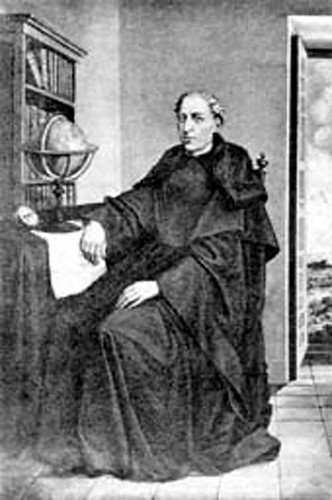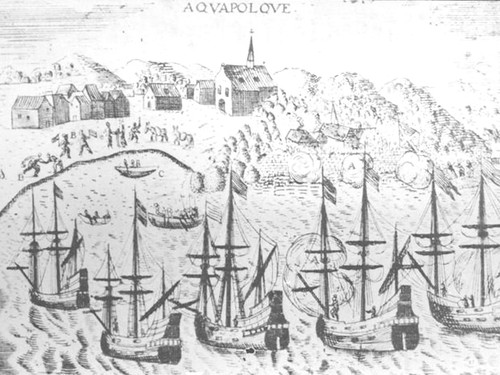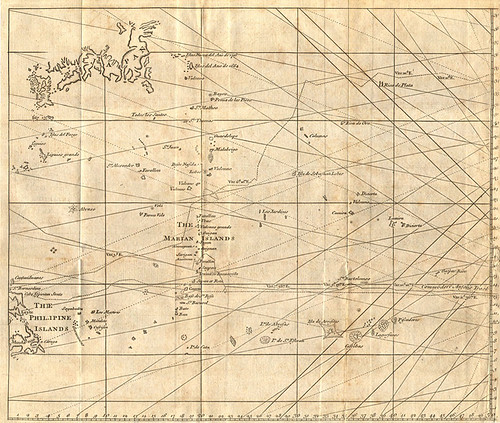The Manila Galleons
On 15 August 1568 the Spanish galleon San Pablo, anchored off the southwest coast of Guam, was hit by a sudden violent storm and was blown and battered onto a nearby coast. The 132 men sailing from Spain’s newly established Philippine colony began a three-month stay on Guam which allowed for intensive interaction with the CHamoru people, alternating between periods of trade and cooperation, and confrontation and violence. The Spanish sailors eventually converted the galleon’s boat into a large bark to return to the Philippines.
The San Pablo, a 400-ton “Manila Galleon” that was part of Miguel de Legazpi’s 1565 expedition to the Philippines, was the first recorded Spanish shipwreck in the Mariana Islands. For 250 years, the Galeón de Manila (Manila Galleons) also known as the La Nao de la China (The China Ships) plied the waters between Acapulco and Manila.
The Treasure Fleet System
The Manila Galleons were part of the Spanish Treasure Fleet system. The Treasure Fleet system emerged as a result of Spain’s conquest of the New World. South and Central America gave Spain possession of the world’s largest source of precious metals. Because Spain had no industry and had to purchase items from other nations, the government ruled that colonists could only trade with Spanish merchant ships. This made trade very profitable for Spain but created tension with other European countries that could not benefit from the monopoly.
It was not long before French and English privateers began to attack the merchant ships. In 1537, French privateers captured nine merchant ships. In order to protect their shipping line, the Spanish government sent a fleet of warships to convoy merchant ships back to port. This is believed to have been the first Spanish Treasure Fleet. The Treasure Fleet had two other lines—the Tierra Firme fleet and the Nueva España fleet.
The Galeón de Manila was added to the Spanish Treasure Fleet in 1565. The ships would sail the Pacific Ocean, running between Acapulco in the Americas and Manila in Las Islas Filipinas, bringing silver from the Americas and returning with precious cargo from the East Indies. The cargo would then be transported by pack animals over land to Vera Cruz where it would be loaded on ships of the Nueva España fleet. The Nueva España fleet would then rendezvous with the Tierra Firme fleet in Cuba and proceed back to Seville, Spain.
This system continued until 1748 when the Tierra Firme fleet was discontinued. In January of 1778 the final voyage of the Nueva España fleet reached Vera Cruz. While the official lines were discontinued, registered ships, either singly or in groups, would continue to make voyages along the same routes but these voyages were irregular and dictated by financial conditions.
The Galeón de Manila continued to run until 1815 when the last ship, the Magallanes left Acapulco for Manila. It then became the longest running shipping line in history.
The Galleon
The term “galleon” is associated closely with the Spanish Treasure Fleet but in reality, the term is more of a generic label and has no standardized meaning. The term was applied to a wide range of crafts bearing certain similarities. The word, “galleon,” is said to be from the Byzantine Greek galea, the French galion, and the Spanish galeón meaning, “Armed Merchant Ship.”
The early ships were moved by oars and primarily built for war, but later versions were powered with wind and functioned more like an armed merchant ship. The typical 16th century galleon was a high-sided vessel with a very tall stern castle structure (usually split into two or more levels), a lower forecastle, a flat stern, a protruding beak at the bow (like a spur on a galley), and usually a single unbroken gun deck. The galleon had a largely flat bottom that curved outward up the sides. The hull sides sloped inward from bottom to top.
The rigging included a bow sprint, a foremast, a mainsail, and one or two mizzenmasts depending on the size of the vessel. The sail plan was largely square-rigged.
The size of the galleons grew over time. In 1593 each galleon was limited to 300 tons. By 1720 the tonnage was increased to 560. While these restrictions were in place, they were never enforced. One of the largest Manila Galleons was built in 1750. The Santisima Trinidad was 167.5 feet in length with a beam of 50.5 feet and a draught (draft/hull) of 30.5 feet. The vessel displaced 2000 tons, had 70 guns and a complement or crew of 413.
Most of the galleons for the Acapulco – Manila line were built in the boat yards of Cavite on the Bay of Manila. The abundance of skilled workmen, wood, and a safe harbor made this location ideal for galleon construction. Sailcloth was produced in the Ilocos province, and cordage was made from “Manila hemp.” Metal brought into the Philippines from China, Japan, Macao and India was worked by Chinese tradesmen.
Early on, some galleons were built in countries such as Japan and Siam (Thailand), but construction of galleons for the Galeón de Manila line was restricted to the Philippines in 1679 by Royal order. One of the benefits to building ships in the Philippines was the hard woods found there were believed to be far superior to those found outside of the islands.
Fray Casimiro Díaz, an 18th century Augustinian, wrote that the wood was, “the best that can be found in the universe,” and, “if it were not for the great strength of the galleons and the quality of the timbers that so dangerous a voyage could not be performed.” Another 18th century chronicler and English privateer Woodes Rogers wrote that the galleons were much stronger than those built in Europe, and that “these large ships are built with excellent timber that will not splinter.”
Teak was often used for the framework of the ship. The hardwood, Molave, was used for the ribs, knees, keel, rudder and other inside work. Lanang was used for sheathing the outside ribs. In his book about the Manila Galleons, William Lytle Schurz wrote that lanang was a “wood of great toughness” that had a “peculiar nature that small cannon balls remained embedded in it, while larger shot rebounded from a hull made of this timber.”
More than 2,000 trees were required to build the largest galleons, cut by gangs of Filipinos in the mountains and transported to the boat yard. Chinese carpenters performed the skilled construction of the ships.
A partial list of galleons
Buen Socorro – believed to be one of the largest and best built galleons.
Nuestra Señora de la Concepción – wrecked off Saipan in 1638. Twenty-eight survivors made it to Guam; six survivors and two CHamorus left Guam in an open boat and arrived in the Philippines nearly dead.
Covadonga – taken by British explorer George Anson in 1743 in the waters of the Philippines.
Espíritu Santo – broken up in 1576 on the island of Cantanduanes; all drowned or were killed by natives of the Philippine Island.
Jesús María – wrecked in Mindanao in 1606.
Magallanes – last of the Manila Galleons.
Magdalena – Due to rotten planks and improper arrangement of the cargo, she turned over on her side at her moorings in Cavite just before departing.
Nuestra Señora de Begoña – In 1718 on her voyage from Acapulco to Manila she carried 105 priests; the crossing took four months and 24 days.
Nuestra Señora de la Encarnación y Desengaño – Captured by privateer Woodes Rogers in 1709 the vessel was renamed the Batcheler. Upon the arrival of the Batcheler in Guam Rogers was received by Governor Juan Antonio Pimentel who presented Rogers with “2 Negro boys dress in liveries, 20 yards of scarlet cloth, and 2 pieces of Cambrick.” Pimentel also provided the ships with cattle, hogs, chickens, corn, rice, coconut and fruit. He also presented the men with a 60-course dinner at the governor’s house. Pimentel would spend many years in prison in Manila for his generosity.
Nuestra Señora de Guadelupe – brought Augustinian Recollect priests to Guam in 1769.
Nuestra Señora de la Vida – The pilot ran the ship aground on a reef only 90 miles from Manila while navigating the departure from the Philippines. Angry passengers hung him on shore.
Nuestra Señora del Rosario – Ordered to change course in 1699 before reaching the Mariana Islands and steer for Cantanduanes in Luzon, the commander and pilots held to the customary course and stopped at Guam. The crew beat off an attack by the St. George and British privateer William Dampier in 1744. In 1772, a patache named Nuestra Señora del Rosario made the Manila–Guam–Manila run
Sacra Familia – took 9 months to reach Acapulco from Manila in 1724.
San Andres San Antonio – Wrecked at sea, location unknown, with great wealth aboard and many leading citizens of Manila who were fleeing the troubles of the city.
San Antonio de Padua – brings first horse to Guam in 1673; in 1679, the vessel brings Jose de Quiroga to Guam.
San Diego – In 1647, the crew helps to repell 12 Dutch ships in Manila Bay; it was later shipwrecked in Manila in 1654.
San Damián – Father Diego Luis de San Vitores, future missionary in the Mariana Islands, was on board in 1662. The vessel was shipwrecked in Philippines.
San Felipe – In 1596, seeking harbor in Japan after being invited in, the ship was run aground purposely and her cargo stolen. Twenty-six missionaries including six Spanish Franciscans and three Jesuits who were passengers on the ship were killed in Nagasaski a year later.
San Fernando – shipwrecked at Guam 1772.
San Francisco – wrecked in Japan in 1609; most of the 400 onboard survive and were treated with consideration, unlike those shipwrecked in 1596.
San Francisco Xavier – took English prisoners from Guam to Manila, 1803.
San Geronimo – In 1566, a storm forces her to put in at Rota in the Mariana Islands; she heads back to Manila but is broken up in Catanduanes, Philippines. Only 8 persons survive.
San Jose – broke up on the island of Lubang, Philippines. Four hundred persons drowned and 12,000 packages destroyed. Padre Casimiro Díaz said, “no larger or richer galleon had ploughed the seas…for the wealth that she carried was incredible.”
San Juan – One of the first two galleons sent from Manila in 1572, captured one CHamoru from Guam.
San Juan de Letran – Put in at Guam.
San Martin – In 1586, 194 citizens of Manila consigned goods on the ship, a large portion of the lay population at the time.
San Nicolas – lost in 1621 with 330 persons.
San Pablo – under the command of Felipe de Salcedo and pilot Andrés de Urdaneta, makes first trade transaction (Manila to Acapulco 1565) bringing cinnamon from Mindanao purchased with the Royal account. The vessel wrecked at Guam in 1568.
San Pedro – Under the command of Felipe de Salcedo and pilot Urdaneta, the San Pedro made its first successful eastern crossing from Manila to Acapulco in 1565.
Santa Ana – the first Manila galleon to be taken by the British. It had no cannon, very little artillery or arms when Thomas Cavendish captured it in his ship the Desire off the coast of America. In 1587, The Santa Ana carried great wealth–over 122,000 pesos of gold, silk, satin, damasks, pearls, musk and other merchandise, food and conserves, sundries and, according to Cavendish, “very good wines.” The total value estimated by the Spanish treasury was at over a million pesos. After stripping it of its cargo, Cavendish hanged passenger Fray Juan de Almendáriz, who was returning from Manila. He deposited 190 Spaniards on the shore with food and arms to defend themselves and set the Santa Ana on fire and adrift. The pilot of the Santa Ana, Alonso de Valladolid, three Filipino pages and two Japanese were pressed into Cavendish’s service. Luckily a breeze blew the ship toward the shore and the remaining Spaniards were able to put out the fire and repair the vessel so that it was able transport them across the gulf of California to Acapulco. The Santa Ana continued on to Manila after a stop in Guam. At Manila, the pilot, Valladolid, was hanged for attempting to inform his countrymen of the taking of the Santa Ana.
Santa Margarita – In 1600, crippled by storms, the Santa Margarita floundered for eight months at sea and finally grounded in the Mariana Islands. Only 50 of 260 persons survived, the dead included the commander and the pilot. Thirty-five were dragged ashore by natives, the remainder drowned as they were being dragged away or were killed by the islanders. The islanders plundered her cargo. A year later, the Santo Tomas took on five of the survivors but broke up in Catanduanes. Commander of the ship Antonio de Ribera Maldonado refused to delay the ship to pick up the remaining 26 survivors. Fray Juan Pobre leaped into a native boat and went to shore to administer to his fellow Spaniards. Then, in 1602 the Jesús María took all but five of the remaining survivors back to Manila.
Santa Rosa – A boat dispatched by Mariana Islands Governor Damian de Esplaña warned the Santa Rosa of the presence of English privateers in Humåtak. The Santa Rosa continued on to Manila without stopping in Guam.
Santissima Trinidad – The ship arrived in Acapulco from Manila with only 27 of 353 people able to muster the strength to stand. Eighty-two had died at sea.
Santiago – Shipwrecked at Guam, 1814.
Santo Cristo de Burgos – burned at sea, wreckage washed up on the beaches of the Mariana Islands. Two survivors made it to the Philippines but one was “without reason” and the other “under the shadow of the Church” for resorting to cannibalism in order to survive.
Santo Domingo – brought Captain Domingo Gomez de la Sierra to serve as Governor in Guam, 1746.
For further reading
Blair, Emma H., James A. Robertson, and Edward G. Bourne, eds. The Philippine Islands, 1493-1803. Vols. 1-55. Cleveland: Arthur H. Clark Company, 1903-1909.
Driver, Marjorie G. The Spanish Governor of the Mariana Islands and the Saga of the Palacio. Mangilao: Micronesian Area Research Center, University of Guam, 2005.
Lévesque, Rodrique. History of Micronesia: A Collection of Source Documents. Vol. 20, Bibliography of Micronesia, Ships through Micronesia, Cumulative Index. Quebec: Lévesque Publications, 2002.
Mateo, José EB. “The arrival of the Spanish galleons in Manila from the Pacific Ocean and their departure along the Kuroshio stream (16th and 17th centuries).” Journal of Geographical Research, no. 47 (2007): 17-38.
Pérez-Mallaìna, Pablo E. Spain’s Men of the Sea: Daily Life on the Indies Fleet in the Sixteenth Century. Translated by Carla Rahn Phillips. Baltimore: Johns Hopkins University Press, 1998.
Peterson, Andrew. “What Really Made the World go Around?: Indio Contributions to the Acapulco-Manila Galleon Trade.” Explorations a Graduate Student Journal of Southeast Asian Studies 11, no. 1 (2011): 3-18.
Schurz, William Lytle. The Manila Galleon. New York: E.P. Dutton & Company, Inc., 1959.
Searles, PJ, USN Commander. “Spanish Galleons.” Guam Recorder, 1940.











